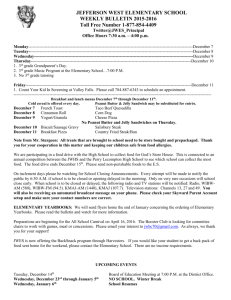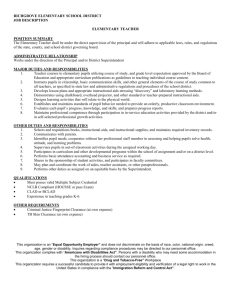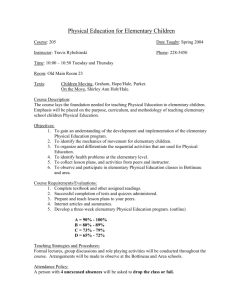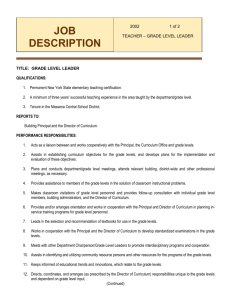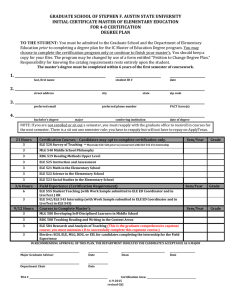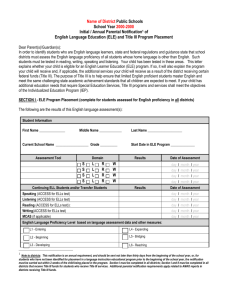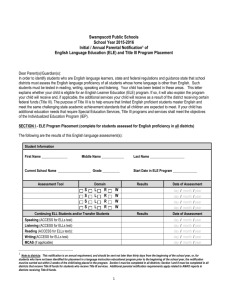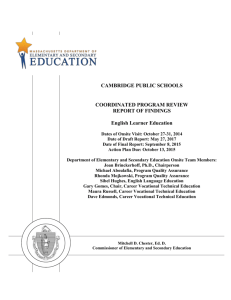ele 3340 - social studies for the elementary school children
advertisement
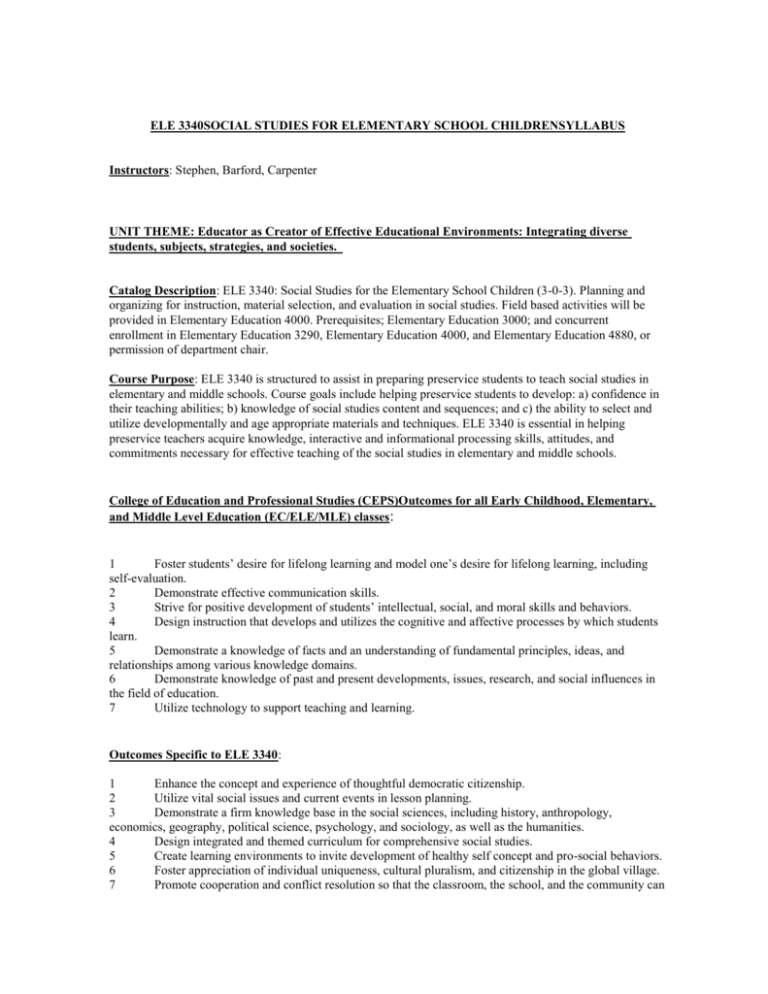
ELE 3340SOCIAL STUDIES FOR ELEMENTARY SCHOOL CHILDRENSYLLABUS Instructors: Stephen, Barford, Carpenter UNIT THEME: Educator as Creator of Effective Educational Environments: Integrating diverse students, subjects, strategies, and societies. Catalog Description: ELE 3340: Social Studies for the Elementary School Children (3-0-3). Planning and organizing for instruction, material selection, and evaluation in social studies. Field based activities will be provided in Elementary Education 4000. Prerequisites; Elementary Education 3000; and concurrent enrollment in Elementary Education 3290, Elementary Education 4000, and Elementary Education 4880, or permission of department chair. Course Purpose: ELE 3340 is structured to assist in preparing preservice students to teach social studies in elementary and middle schools. Course goals include helping preservice students to develop: a) confidence in their teaching abilities; b) knowledge of social studies content and sequences; and c) the ability to select and utilize developmentally and age appropriate materials and techniques. ELE 3340 is essential in helping preservice teachers acquire knowledge, interactive and informational processing skills, attitudes, and commitments necessary for effective teaching of the social studies in elementary and middle schools. College of Education and Professional Studies (CEPS)Outcomes for all Early Childhood, Elementary, and Middle Level Education (EC/ELE/MLE) classes: 1 Foster students’ desire for lifelong learning and model one’s desire for lifelong learning, including self-evaluation. 2 Demonstrate effective communication skills. 3 Strive for positive development of students’ intellectual, social, and moral skills and behaviors. 4 Design instruction that develops and utilizes the cognitive and affective processes by which students learn. 5 Demonstrate a knowledge of facts and an understanding of fundamental principles, ideas, and relationships among various knowledge domains. 6 Demonstrate knowledge of past and present developments, issues, research, and social influences in the field of education. 7 Utilize technology to support teaching and learning. Outcomes Specific to ELE 3340: 1 Enhance the concept and experience of thoughtful democratic citizenship. 2 Utilize vital social issues and current events in lesson planning. 3 Demonstrate a firm knowledge base in the social sciences, including history, anthropology, economics, geography, political science, psychology, and sociology, as well as the humanities. 4 Design integrated and themed curriculum for comprehensive social studies. 5 Create learning environments to invite development of healthy self concept and pro-social behaviors. 6 Foster appreciation of individual uniqueness, cultural pluralism, and citizenship in the global village. 7 Promote cooperation and conflict resolution so that the classroom, the school, and the community can be democratic microsocieties. 8 Identify criteria by which one decides what will be learned and what instructional strategies will be employed to deliver that learning. 9 Incorporate state, national, and National Council for the Social Studies standards in social studies lesson planning and instructional delivery. 10 Incorporate up-to-date technology and telecommunications in lesson planning and instructional delivery. 11 Promote higher-order thinking and decision making based upon involvement with critical social issues. 12 Design authentic, appropriate, and varied forms of evaluation for social studies. 13 Manage the social studies classroom to optimize academically engaged time. 14 Teach so that critical citizenship education can result in constructive social action. Learning Model: Social Systems This model is constructed to take advantage of the collective energy people generate when working together by building learning communities. Learning is viewed as an interaction between the student and critical aspects of the school and home environment and focuses on the whole ecosystem, not just the learner. The model is designed to lead students to define problems, explore various perspectives of the problems, and study together to master information, ideas, and skills. The teacher organizes the group process and disciplines it, helps the students find and organize information, and ensures a vigorous level of activity and discourse. (Models of Teaching by B. Joyce, M. Weil, and B. Showers; 1992; Boston: Allyn and Bacon.) Texts: Welton, David. A., and Mallan, John T. Children and Their World: Strategies for Teaching Social Studies. 6 Edition. Boston: Houghton Mifflin Company, 1999. th National Council for the Social Studies. Expectations of Excellence: Curriculum Standards for the Social Studies. Upper Saddle River, NJ: Prentice-Hall, Inc., 1998. Supplemental Materials: Provided by instructor. Course Requirements and PointsGrading Scale Final Exam = 100 pt.A = 92% or higher B = 91% to 83% Midterm Exam = 50 pt. C = 82% to 75% D = 74% to 67% Projects/Units/Guides = 100 pt. F = 66% or below Projects, units, and/or guides require students to demonstrate proficiency in word processing and application of technology skills in researching topics from multiple sources, including the World Wide Web. Group Presentations = 10-25 pt. each Group presentations require students to utilize appropriate terms and apply productivity tools which may include LCD panel projectors; printers; software such as Power Point, Claris, HyperStudio; or other overhead displays and technology tools. Journal/Internet Reviews = 10-25 pt. each Journal/Internet/Website reviews require students to locate relevant social studies sources and provide an evaluation by submitting a rubric-based reaction paper utilizing word processing. Participation = 25 pt. Participation expectations of students include attendance, discussion, and engagement in regular correspondence via email between and among peers, course instructors, and other professionals. Note: The syllabus is tentative and subject to change according to class needs and decisions. Specific guidelines for projects and presentations will be distributed and discussed in advance of due dates. Attendance and participation are essential. If you are absent, you obviously cannot participate. No late work will be accepted, with the exception of special circumstances. COURSE OUTLINE WEEK SESSION CONTENT READING ASSIGNMENTS SOCIAL STUDIES CONTEXTS: 1 Overview: Course/Requirements 2 Social Studies Dynamics Prologue, Chapter 1 Democratic Citizenship 3 Social Studies Knowledge Base Chapter 2 •Group Presentations 4 Diversity - Cultural Pluralism Chapter 3 Children’s Literature Videos Simulations Group Presentations Technology SOCIAL STUDIES FRAMEWORK: 5 Social Studies Programs Chapter 4 Goals and Standards Curriculum Models •Technology 6 Instructional Themes Chapter 5 Children’s Literature The Arts •Group Presentations 7 Values Education Chapter 6 •Moral Dilemmas •Simulations 8 Values Education Chapter 6 Special Interest Groups Censorship SOCIAL STUDIES INSTRUCTION: 9 Literacy Chapter 7 Learning Styles 10 Teaching Strategies Chapter 8 Cooperative Learning 11 Active Learning Chapter 9 •Demonstrations 12 Planning/Orchestrating Instruction Chapter 10 Integrated Projects Multidisciplinary Lessons Co-Teaching 13 Assessment Chapter 11 •Rubrics 14 Processing Information Chapter 12 •Critical Thinking •Simulations 15 Maps, Globes, and Graphics Chapter 13 Resources Technology •Children’s Literature 16 Other Instructional Tools Chapter 14 Resources Children’s Literature World Wide Web 16 Course Review/Closing Thoughts Epilogue Suggested Journals for Article Reviews Educational Leadership Social Education American Education Elementary School Journal Phi Delta Kappan Schools in the Middle Journal of Staff Development Childhood Education Learning The Reading Teacher Educational Forum The Clearing House Journal of Teacher Education The Social Studies Teacher Social Studies & The Young Learner Theory and Research in Social Education Suggested Article Topics Cultural Diversity Mastery Learning Curriculum Racism Global Education Poverty At-Risk Students Teaching Styles Inclusion Curriculum Integration Community Involvement Technology Moral/Character Education Cooperative Learning Standards Authentic Assessment Instructional Strategies The Internet Suggested Readings: (* Denotes CEPS Knowledge Base author.) Avery, P. and Graves, M. 1997. “Scaffolding Young Learners’ Reading of Social Studies Text.” Social Studies and The Young Learner, 9, 10-14. * Banks, J. 1992. “Multicultural Education: For Freedom’s Sake.” Educational Leadership, 49, 32-36.Berman, S. 1990. “Educating for Social Responsibility.” Educational Leadership, 48, 75-83.Boyer. E.L. 1990. “Civic Education for Responsible Citizens.” Educational Leadership, 48, 4-7.Brett, M. 1996. “Teaching Extended Class Periods.” Social Education, 60, 77-79. * Brophy, J. et al. 1992. “Fifth Graders’ Idea About History Expressed Before and After Their Introduction to the Subject.” Theory and Research in Social Education, 20, 440-489. * Bruner, J. 1983. “Education as Social Intervention.” Journal of Social Issues, 39, 129-141. ________. 1961. The Process of Education. Cambridge, MA: Harvard University Press. Connor, M. 1997. “Teaching United States History Thematically.” Social Education, 61, 203-205. * Dewey, J. 1938. “What is Social Study?” Progressive Education, 15, 367-369. Denton, K. and Muir, S. 1994. “Making Every Picture Count: Ethnicity in Primary Grade Textbook Photographs.” Social Education, 58, 156-158. Enedy, J., Graham, P. T., and Cline, P. 1994. “An Interdisciplinary Approach to Teaching Christopher Columbus.” Social Education, 58, 149-151. Fryemier, J. et al. 1996. “Values and the Schools: Sixty Years Ago and Now.” Phi Delta Kappa Research Bulletin, 17, 1-2. Fulwiler, B. and McGuire, M. 1997. “Storypath: Powerful Social Studies Instruction in the Primary Grades.” Social Studies and The Young Learner, 9, 4-7. Gartenhaus, A.R. 1993. Minds in Motion: Using Museums to Expand Creative Thinking. San Francisco: Caddo Gap Press. Grelle, B. and Metzger, D. 1996. “Beyond Socialization and Multiculturalism: Rethinking the Task of Citizenship Education in a Pluralistic Society.” Social Education, 60, 147-151. * Glasser, W. 1990. “The Quality School.” Phi Delta Kappan, 71, 424-435.Hilliard, A.G. 1992. “Why We Must Pluralize the Curriculum.” Educational Leadership, 49, 12-15.Hirsch, E.D., Jr. 1987. Cultural Literacy: What Every American Needs to Know. Boston: Houghton Mifflin. Hoffbauer, D. and Prenn, M. 1996. “A Place to Call One’s Own: Choosing Books about Homelessness.”Social Education, 60, 167-169.Hollister, B. 1995. “Social Math in the History Classroom.” Social Education, 59, 14-16. * Hunter, M. 1988. Mastery Teaching. El Segundo, CA: TIP Publications. * Johnson, D.W. and Johnson, R.T. 1990. “Social Skills for Successful Groupwork.” Educational Leadership, 47, 29-33. ________. 1989. Cooperation and Competition: Theory and Research. Edma, MN: Interaction BookCo.Kirkman, J. 1995. “Teaching about Local History Using Customized Photographs.” Social Education, 59,11-13.Koeller, S. 1996. “Multicultural Understanding Through Literature.” Social Education, 60, 99-103.Kozol, J. 1991. Savage Inequalities. New York: Crown Publishers.Lamme, L. 1994. “Stories from Our Past: Making History Come Alive for Children.” Social Education, 58,159-164.Lindquist, T. 1995. Seeing the Whole Through Social Studies. Portsmouth, NH: Heinemann.________. 1997. Ways That Work: Putting Social Studies Standards into Practice. Portsmouth, NH:Heinemann.Miculka, L. 1997. “Photographs Slide into the Classroom.” Social Studies and The Young Learner, 9, 810. National Council for the Social Studies. 1981. “Essentials of the Social Studies.” Social Education, 45, 162-164. ________.1994. Expectations of Excellence: Curriculum Standards for the Social Studies. Washington, DC: NCSS. * Parker, W.C. 1990. “Assessing Citizenship.” Educational Leadership, 48, 17-22.Ravitch, D. 1989. “The Revival of History: A Response.” The Social Studies, 80, 144-149.Romanowski, M. 1996. “Problems of Bias in History Textbooks.” Social Education, 60, 170-173.Rowe, J. 1990. “To Develop Thinking Citizens.” Educational Leadership, 48, 43-44.Schur, J. B. 1995. “Students as Social Science Researchers: Gender Issues in the Classroom.” SocialEducation, 59, 144-147.Scott, K. 1995. “Seventy-Five Years Later … Gender-Based Harassment in Schools.” Social Education,59, 293-297.Selwyn, D. 1995. “Arts and Humanities in the Social Studies.” Social Education, 59, 71-77.Shotick, J. and Walsko, G. 1997. “Using Children’s Theater to Teach Economics.” Social Studies and TheYoung Learner, 9, 11-13.Simmons, J. S. (ed.). 1994. Censorship: A Threat to Reading, Learning, Thinking. Newark, DE:International Reading Association. * Slavin, R. 1990. “Cooperative Learning Models for the 3 Rs.” Educational Leadership, 47, 31-33. Yeager, E., Doppen, F., and Otani, E. 1997. “State History and African American History: An Interdisciplinary Civil Rights Approach.” Social Studies and The Young Learner, 9, 14-17. Note: Various themed issues of Phi Delta Kappan, Educational Leadership, and Social Education are of exceptional value and relevance. Suggested Websites National Council for the Social Studies Illinois State Board of Education The PBS Democracy Project The White House Library of Congress World Wide Web Home Page Smithsonian Institution Web Museum US Holocaust Museum Museum of Fine Arts Discovery Channel Online The History Channel Arts & Entertainment Channel PBS Online Social Studies History/Social Studies Site for K-12 Teachers Internet Resources for Social Studies Education GlobaLearn Art & Art Education Historic Documents Gateway to World History Economics Resources for K-12 Teachers Children’s Literature World Health Organization Wall Street Journal USA Today http://www.ncss.org http://www.isbe.il.us http://www.pbs.org/democracy http://www.whitehouse.gov http://lcweb.loc.gov http://www.si.edu http://www.emf.net/louvre http://www.ushmm.org http://www.mfa.org http://www.discovery.com http://www.historychannel.com http://www.AandE.com http://www.pbs.org http://www.csun.edu http://www.execpc.com http://www.indiana.edu http://www.globalearn.org http://www.artusa.org http://www.ukans.edu http://neal.cstate.edu http://ecedweb.unomaha.edu http://www.ucalgary.ca http://www.health.org http://www.wsj.com http://usatoday.com


